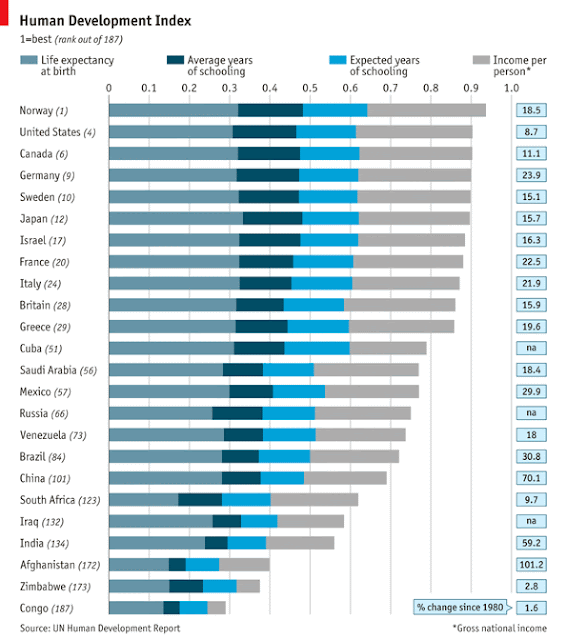Growing Economies - Indicators of growth - 4.1.1
GDP (Gross Domestic Product) - The total value of output (goods
and services) produced in the UK in a particular time period, used to
measure change in economic activity.
To assess the economies development of growing economies the following indicators can be used;
NATIONAL INCOME / POPULATION
To assess the economies development of growing economies the following indicators can be used;
- GDP (represented in US dollars ($), which allows for direct campariosn between countires)
- Literacy
- Health
- Human Development Index (HDI)
GROSS DOMESTIC PRODUCT
The main measure used is GDP and is calculated by - NATIONAL INCOME / POPULATION
Gross domestic product is the economic activity of a country and shows its up and downs if measured over time, known as the business cycle.
This is the most commonly used method to measure a country's living standards. As GDP per capita rises, it is also assumed that living standards in that country also rise.
LITERACY
This refers to the percentage of adults who can read and write. Investment in human capital raises the average level of literacy in an economy and could also have large economic returns if the average levels of skills such as literacy increases in that economy.
By developng literacy throughout the population, there is likely to be higher levels of growth than countries that have a significant difference between high and low skilled workers.
Developing the skills and qualifications of the workforce can lead to significant benefits for an economy in terms of growth and development:
- There is a close correlation between increased productive capacity and the development of human capital as the workforce improves
- Educational achievement and the development of cognitive skills will allow individuals to operate the capital goods within a country
- A highly skilled labour force will lead to increased capacity utilisation within the economy as the workforce are better able to use the current capital equipment
- It will also lead to physical capital development as human capital utilse their skills to increase productive capacity.
HEALTH
Key measures such as average life expectancy, mortality rates among babies and access to helathcare, all of which are linked to economic growth in an emerging economy.
A healthy labour force is likely to be more productive and strong health levels will be less of a burden on resources.
Child health affects literacy and this will provide a supply of workers to deliver future growth.
A lack of health disproportionately affects poor people as they rely on their physical body to earn. This is particularly true of people in less developed countries.
HUMAN DEVELOPMENT INDEX (HDI)
This is a weighted mix of measurements that shows life expectancy, knowledge (adult literacy and education including years of schooling) and standard of living (GDP per capita). As each economy is ranked against these 3 measurements, it then gets put into a index with 1 being the best and 0 being the worst. This allows the index to be set out like a league table with four divisions; very high human development, high human development. medium high human development and low high human development.
The problems with using these measurements to measure economic growth include the fact that they all consider the average of the population without taking into account that there may be large imbalances in the country such as poverty and deprivation not being taken into account and that in certain countries the data is not always reliable.



Comments
Post a Comment